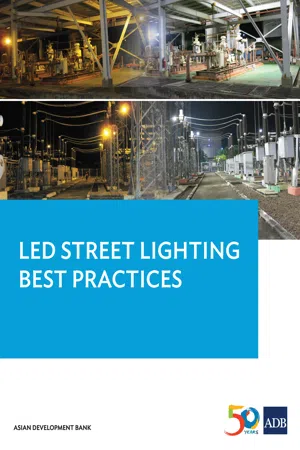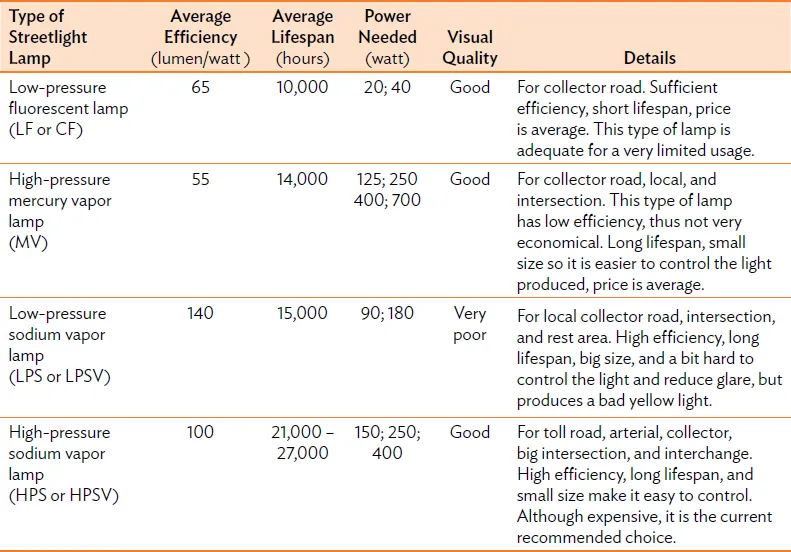![]()
Appendix 1: Current Street Lighting Standards in Indonesia
Standard of street lighting in Indonesia. The street lighting standard in Indonesia is referred to as Standar Nasional Indonesia (SNI), which covers several laws related to the design and implementation of street lighting in Indonesia:
| (i) | Regulation of Ministry of Transportation No. PM.81 of 2011: Standard of Minimum Service for Local Transportation – Provincial and Municipality/District. In the appendix of the regulation, it is mentioned that, for road transportation (angkutan jalan), point c. “Fasilitas Perlengkapan Jalan”: The indicator for the Minimum Service Standard is the availability of road equipment (road signs, road markings, and guardrails) and streetlights for a provincial road. |
| (ii) | Regulation of President Republic of Indonesia No. 8 of 2011: Electricity Tariff Provided by PT PLN. In article 2.e, Basic Tariff for Public Office Building and Streetlight, streetlights are included in the low voltage group (P-3/TR). |
| (iii) | Regulation of Ministry of Public Works No. 19/PRT/M/2011: Road Technical Requirement and Road Technical Planning Criteria. Chapter II, Article 33: Streetlights are not mandatory, except for the following places: |
| a. | cross-section place with a lot of pedestrians, |
| b. | parking area, |
| c. | area with limited visibility distance, and |
| d. | street lighting poles are mounted on the outer side of the road and/or in the middle of the road’s median. |
| (iv) | SNI 7391:2008: Specification of Street Lighting for Urban Area. Consists of lighting for street lane, cross-section on one-lane and multilane, bridge, and tunnel in an urban area, which are functionally classified as arterial, collector, and local roads. The specification covers function, type, dimension, installation, location, and arrangement of streetlights. |
| (v) | SNI No. 04-6262-2000: Recommendation on Lighting for Vehicles and Pedestrians Identical to CIE TC 12:1997: The Lighting of Roads and Motorized Traffic. |
Some of the functions of streetlights include
| (i) | providing contrast between objects and road surface; |
| (ii) | helping to navigate people that use the road; |
| (iii) | increasing safety and comfort for people that use the road, especially at night; |
| (iv) | ensuring a more secure environment; and |
| (v) | providing aesthetics for the road. |
A unit of streetlight consists of
| (i) | lamp/luminaire; |
| (ii) | optical elements (reflector, refractor, and diffuser); |
| (iii) | electronic elements (connector to power supply, etc.); and |
| (iv) | supporting elements consisting of the arms, vertical pole, and foundation of the pole. |
Based on the SNI regulation, the use of street lighting is differentiated based on the following street classes:
| (i) | Main/primary road. A road that accommodates the local and regional activities. It is usually very busy and, thus, needs optimum lighting. Referring to SNI 2000, the street lighting required is 50 lux. |
| (ii) | Arterial road. A road that supports the activity of the main road. Congestion is quite heavy and, thus, the road requires the same street lighting specification as the main road. According to SNI 2000, the streetlight requirement is 50 lux. |
| (iii) | Main/primary collector. A road that accommodates traffic from the surrounding area that will end up in the main or secondary road. According to SNI 2000, the street lighting required is 30 lux. |
| (iv) | Arterial collector. A road that serves as a collector from the surrounding area that will end up in the primary collector, primary road, or secondary road. This requires a street lighting specification that is equal to a primary collector. According to SNI 2000, the street lighting required is 30 lux. |
| (v) | Neighborhood street. A road in a housing complex, village, or residential area in general. This requires 15 lux. |
In accordance with Regulation No. 12/BNKT/1991, streetlights can be assessed from their characteristics and usage shown in Table A1.
Table A1: Characteristics and Usage of Streetlight Lamps
HPS or HPSV = High-pressure sodium vapor lamp, LF or CF = Low-pressure fluorescent lamp, LPS or LPSV = Low-pressure sodium vapor lamp, MV = High-pressure mercury vapor lamp.
Source: Regulation No. 12/BNKT/1991: Streetlight Specification for Municipal Roads.
![]()
Appendix 2: Overview of Regulations for Public–Private Partnerships
Presidential Regulation No. 38/2015
The recently adopted Presidential Regulation No. 38/20151 is expected to accomplish the following five objectives:
| (i) | Emphasize the authority of the parties involved in public–private partnerships (PPPs). |
| (ii) | Expand the scope in the implementation of PPP. |
| (iii) | Accelerate the business process from preparation to transaction. |
| (iv) | Increase the bankability and sustainability of projects, including the possibility of alternative financing. |
| (v) | Provide legal certainty in the PPP processes (e.g., the success fee mechanism, land acquisition, and environmental impact assessments). |
The following are several noteworthy points that will likely impact energy efficiency and energy services company work:
Energy Conservation and Types of Projects Covered
(Chapter 5) There are 14 infrastructure development types of works identified in the regulation. One type is “infrastructure on energy conservation.”
(Chapter 21) The identification of an infrastructure project needs to be in line with the long- and medium-term national and regional plans.
Stakeholders
(Chapter 6) The government agencies or entities who can establish PPPs are ministries, government institutions, and local governments (provincial and municipalities).
Project Structure
This new Presidential Regulation provides a basis for several PPP projects to be bundled and carried out under a single procurement process. The relevant authority for each PPP project that is bundled with another PPP project must act jointly as the government contracting agency. It also allows for the scope of PPP projects to include commercial activities, which can serve as a basis for business entities to develop commercial areas to support the project revenue streams.
Payment and Government Support
(Chapter 10) The government can lend land or facilities for the purpose of project implementation.
(Chapter 12) Allows paymen...

